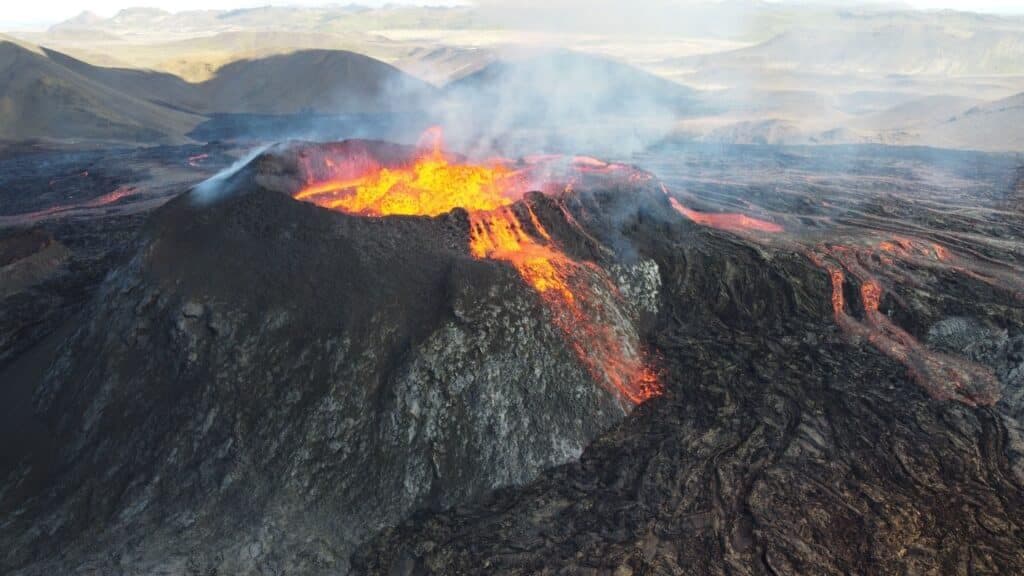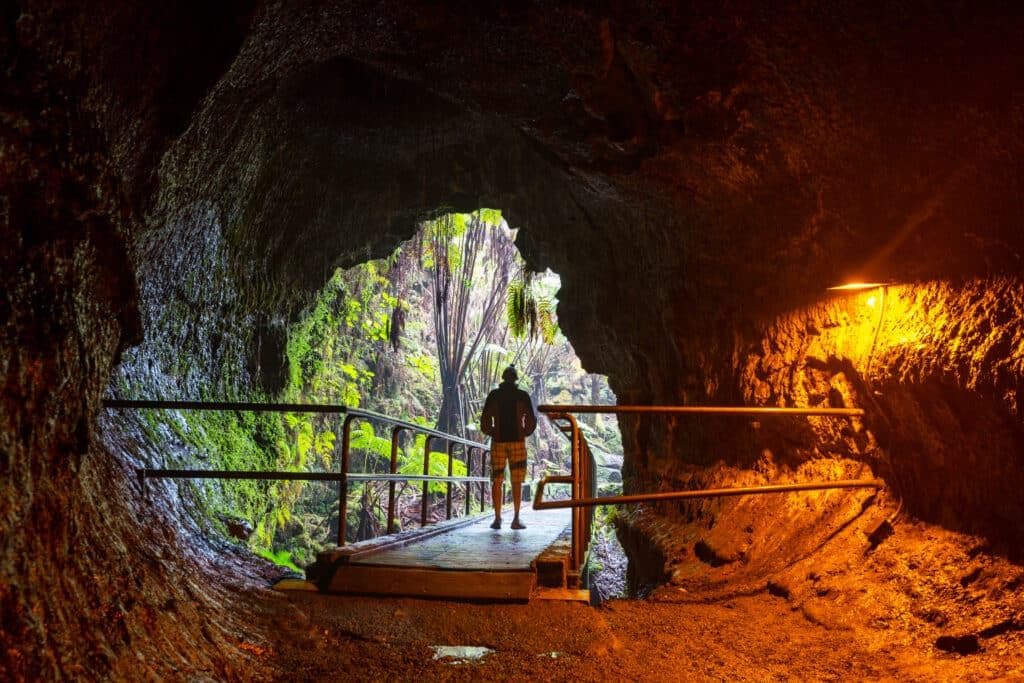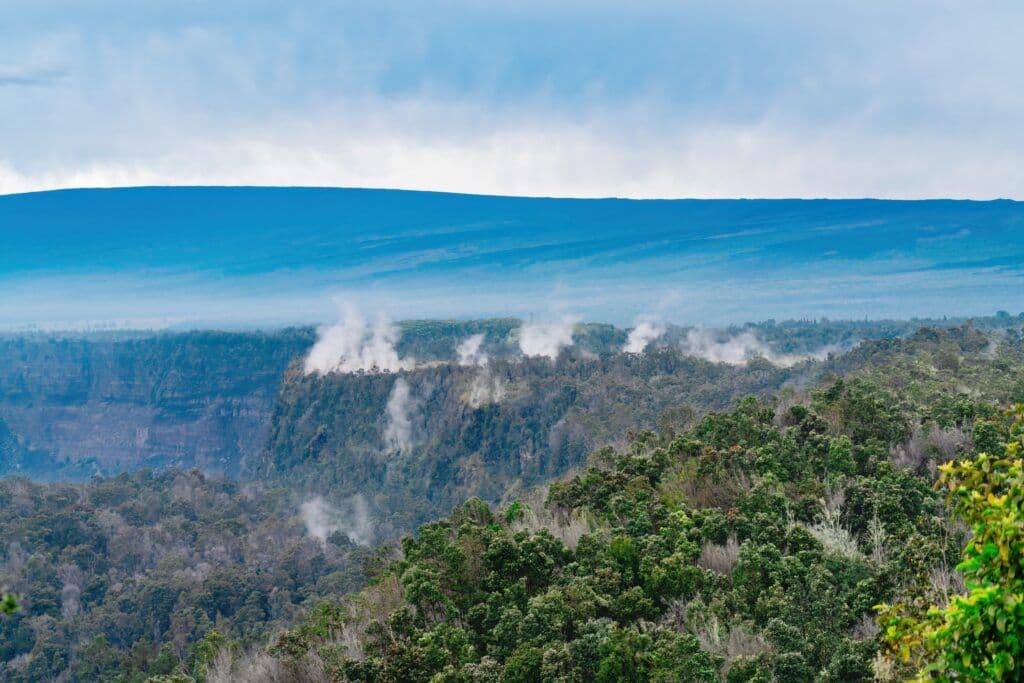By Kristy Lynn
Big Island
Big Island Nature & Parks
Hawaiian Culture
Kauai
Kauai Nature & Parks
Lanai
Maui
Maui Nature & Parks
Molokai
Oahu
Oahu Culture & History
Oahu Nature & Parks
Things to Do on Kauai
Things to Do on Maui
Things to Do on Oahu
Things to Do on the Big Island
Visiting Hawaii
I didn’t grow up around volcanoes in Hawaii, but I did spend my childhood surrounded by volcanoes deep in the jungles of Central America. When I first arrived in Hawai‘i and looked up at those shadowy, sleeping giants, I felt an eerie sense of familiarity. The awe was immediate, and so was the humility.
Volcanoes in Hawaii aren’t just geographical features; they’re the creators, the legends, and the living pulse of these islands. Whether you’re a geology buff, an adventure traveler, or simply curious about Earth’s raw power, visiting Hawaii’s volcanoes is an experience like no other. But understanding them is what connects you to the land.

Mauna Loa Volcano in Hawaii (Shutterstock)
One of the most common questions travelers ask is: how many volcanoes are in Hawaii? The answer depends on how you define them. The Hawaiian island chain was formed through volcanic activity, with magma surfacing from beneath the ocean to create each island. Each island was formed by a hotspot in the Earth’s mantle, with older islands eroding as new ones formed. The Big Island is currently the youngest and most volcanically active.
There are six major volcanoes on the Big Island: Kīlauea, Mauna Loa, Mauna Kea, Hualālai, Kohala, and Lo‘ihi (submerged offshore).
Across all the Hawaiian Islands, there are 15+ major volcanic structures, most dormant or extinct.
If you’re going to see volcanoes in Hawaii, Hawai‘i Volcanoes National Park on the Big Island is the crown jewel. A UNESCO World Heritage Site, it’s one of the most unique national parks in the U.S.
Night hike to Halemaʻumaʻu Crater = otherworldly. The glow, the stars, the silence. Nothing compares. #HawaiiVolcanoes” — @lavajunkie
Hawaiʻi Volcanoes National Park is home to the prominent volcanoes Kīlauea and Mauna Loa, which have played a crucial role in shaping the Hawaiian islands. Kīlauea is particularly significant due to its frequent activity and its cultural connection to the Hawaiian goddess Pele.
Kīlauea Caldera & Halemaʻumaʻu Crater – where lava dramatically surfaced as recently as 2023
Chain of Craters Road – a scenic drive through old lava flows down to the coast
Thurston Lava Tube – a walkable cave formed by flowing lava
Mauna Loa Trail – a challenging trek up the world’s largest volcano by volume

lava tube on the Big Island (Shutterstock)
Yes, there are still active volcanoes in Hawaii and you can witness their awe-inspiring power up close. Whether it’s seeing the glow on the horizon or walking across a hardened lava field, visiting these fiery giants is an unforgettable experience. But safety comes first. Always check the USGS Volcano Updates website before planning a trip.
Kīlauea: One of the world’s most active volcanoes. It erupted fairly continuously from 1983 to 2018, with recent activity again in 2023. You can see it at Hawai‘i Volcanoes National Park via the Kīlauea Overlook, Crater Rim Trail, and Halemaʻumaʻu Crater. If the lava lake is active, you might catch a fiery glow after sunset. Guided ranger walks are also available.
Mauna Loa: The largest volcano on Earth. After 38 years of dormancy, it erupted again in late 2022. Some of the best distant views are from Saddle Road. The Mauna Loa Observatory Road offers a closer look when conditions permit. For hiking enthusiasts, the Mauna Loa Trail offers a high-altitude adventure through raw volcanic terrain.
Hualālai: The third most active volcano in Hawaii. Its most recent eruption was in 1801, and it has displayed significant volcanic activity over the past millennia. While this volcano hasn’t erupted in over 200 years, you can explore its ancient lava flows in the Kona area. Trails in Kaloko-Honokōhau National Historical Park give you a sense of the land Hualālai helped shape. Eco-tours also provide insight into its geology and historical eruptions.
The United States Geological Survey (USGS) and Hawaiian Volcano Observatory (HVO) play a crucial role in monitoring volcanic activity in Hawaii. Utilizing a network of seismic stations, cameras, and gas sensors, the HVO tracks volcanic activity and provides essential information to the public and emergency management officials.
The HVO keeps a close watch on the six active volcanoes on the Big Island and Maui, including Kīlauea, Mauna Loa, Mauna Kea, Hualālai, Haleakalā, and Lō‘ihi. These volcanoes are classified as shield volcanoes, characterized by their gently sloping shape and the presence of extensive lava flows. Additionally, the HVO monitors the East Rift Zone, a 125-kilometer-long zone of volcanic activity that runs along the eastern side of Kīlauea.

Volcanoes National Park (Shutterstock)
The best way to explore these natural wonders? A guided Hawaii volcano tour. Whether by air, foot, or 4×4, tours provide expert insight and safe access.
Tour types:
Helicopter Tours: Soar over lava fields, craters, and hidden waterfalls
Hiking Tours: Explore hardened lava flows, steam vents, and volcanic craters
Cultural Tours: Learn about Native Hawaiian stories and spiritual connections to the land
Recommended Operators:
“Took a chopper over Kīlauea and saw actual red lava. I cried. That’s it. #volcanoesinhawaii” — @skyabovehawaii
While most volcano tourism focuses on the Big Island, each island tells a volcanic story:
Maui: Home to Haleakalā, a massive shield volcano with an epic sunrise view at its 10,000-foot summit. Haleakalā rises significantly above sea level, emphasizing its geological prominence.
Oahu: Hike up Diamond Head, an extinct volcanic cone with panoramic Honolulu views
Kauai: The oldest island, home to Mount Wai‘ale‘ale, one of the rainiest places on Earth and shaped by ancient volcanic erosion
Volcanoes are deeply rooted in Hawaiian tradition. According to legend, the goddess Pele dwells in Kīlauea. She is the goddess of fire, lightning, and volcanoes — a powerful force of destruction and creation.
Visitors are encouraged to respect local beliefs. For instance, removing lava rocks is considered both disrespectful and bad luck (and yes, people really do mail them back after experiencing misfortune!).
“Left a lava rock in my suitcase… flight got canceled twice. Mailed it back to Pele with an apology. Not risking it again.” — @islekarma
Hawaii has a long history of volcanic eruptions, with some of the most significant events occurring in recent centuries. One of the most notable eruptions was the 1983-2018 eruption of Kīlauea, which holds the record as the longest-erupting volcano in recorded history. During this period, lava flows destroyed several communities and created new land, dramatically altering the landscape.
Another significant eruption occurred in 2018, when Kīlauea’s East Rift Zone erupted, producing large amounts of lava and gas. This caused widespread damage, destroying hundreds of homes and businesses.
Mauna Loa, the largest volcano on Earth, has also had several significant eruptions in recent decades. In 1984, a 22-day eruption produced lava flows that reached within 7.2 kilometers of Hilo. More recently, in 2022, a two-week eruption produced lava flows that came within 1.7 miles of the Daniel K. Inouye Highway. These eruptions serve as powerful reminders of the dynamic nature of Hawaii’s volcanic landscape.
One of the most iconic volcanic landscapes in Hawaii is the Kīlauea caldera, a large depression in the summit of Kīlauea formed by a series of explosive eruptions. The caldera is home to a lava lake, which has been erupting intermittently since 2008, offering a mesmerizing display of nature’s raw power.
Mauna Loa, the largest volcano on Earth, also features a number of unique formations, including the Mokuaweoweo caldera, a large depression on the summit. The caldera is surrounded by a series of volcanic cones and lava flows that have erupted over millions of years, creating a landscape that is both rugged and beautiful.
Hawai‘i Volcanoes National Park offers a range of hiking trails, scenic drives, and educational programs that allow visitors to explore the unique volcanic landscapes and features of the islands. Whether you’re trekking through a lava tube or gazing into a glowing crater, the park provides an unforgettable experience of Hawaii’s volcanic wonders.
Dress in layers: Even tropical volcanoes can get chilly at elevation.
Bring water and snacks: Services are limited, especially in national parks.
Respect closures and signage: Lava zones and vents can shift quickly.
Use a headlamp: Sunrise and sunset hikes are popular, but trails can be dark.
Leave no trace: Preserve the landscape for future generations.
To capture the drama of volcanoes in Hawaii, try these photo strategies:
Visit at golden hour: Lava glows best at dawn or dusk.
Use a tripod and use long exposure: To catch nighttime glow or stars above lava.
Bring a zoom lens: Stay safe while getting dramatic close-ups.
Include scale: A person or tree in the frame helps show the vastness.
Big Island:
Hilo: Closest city to Hawaii Volcanoes National Park
Volcano Village: Quaint rainforest town near the park entrance
Maui:
Kula or Makawao: Upcountry towns near Haleakalā
Kihei or Lahaina: A great base for exploring Haleakalā and the beaches
To stand near active volcanoes in Hawaii is to witness Earth’s power in real time. These aren’t just landmarks — they’re sacred sites, geological wonders, and the foundation of every palm tree and black sand beach.
Whether you’re flying over a glowing crater or feeling the warmth of the earth under your boots, the volcanoes of Hawaii offer more than just Instagram moments — they give you a rare connection to the living planet. So go slow, tread lightly, and let the islands share their stories with you.
Join our newsletter for travel inspiration, insider tips and the latest island stories.
By subscribing, you agree to receive emails from Hawaii.com. You can unsubscribe anytime. See our Privacy Policy.